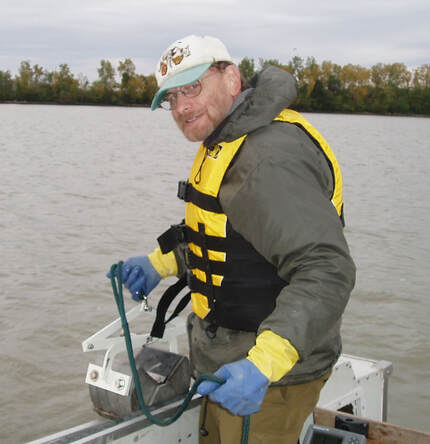RamLab's Mission
Notice: We recently had a community outreach event about biodiversity in Palmer Park
Click here to see documentation, location and content.
The goal of the Ram laboratory is to provide a factual base for future action and an inventive spirit in finding solutions to human health and environmental problems, with a special focus on the Great Lakes. In the COVID-19 epidemic, the RamLab has been applying its molecular aquatic technologies to detect markers of SARS-CoV-2, the virus that causes COVID-19, in wastewater. Wastewater detection of SARS-CoV-2 can give up to a week's early warning of new outbreaks in a community, a capability that may become increasingly important for detecting and breaking new outbreaks in the post-vaccine era.
The Great Lakes are a global resource for fresh water, transportation, recreation, ecosystem services, and biological diversity. This resource must be restored and protected. With experience in micro-, molecular, and marine biology, the Ram laboratory is engaged in research dealing with biodiversity, invasive species, and microbial contamination. While the biota of the Great Lakes have undergone vast recent changes due to intentional and accidental introductions of non-native organisms, many of the diverse aquatic invertebrates that are potentially affected by these changes are surprisingly little described and understood. The laboratory has projects dealing with detection, identification, physiology, and ecosystem function of both native and non-native Great Lakes invertebrates. Human health related significance of this research stems from the role in human health of aquatic disease vectors, such as mosquitos and their predators, microbial pathogens that may be encountered at beaches, and chemical contaminants that may be bioamplified differently in native and non-native impacted ecosystems.
Past and ongoing projects include bioinformatic and regulatory roles of glutathione and its derivatives on calcium sensors and invertebrate reproduction, the physiology and diversity of invasive mussels (zebra mussels and others) and other aquatic invertebrates, application of DNA technologies to the detection and analysis of invasive species and pathogens, molecular tools for fish identification and restoration, and development of technologies to prevent invasive species from being discharged by ships into the Great Lakes. In the COVID-19 epidemic, the RamLab has been applying its molecular aquatic technologies to detect markers of SARS-CoV-2, the virus that causes COVID-19, in wastewater. Wastewater detection of SARS-CoV-2 can give up to a week's early warning of new outbreaks in a community, a capability that may become increasingly important for detecting and breaking new outbreaks in the post-vaccine era. Our methods are described in the following publication: https://authors.elsevier.com/c/1fULFB8ccuoVx
Click here to see documentation, location and content.
The goal of the Ram laboratory is to provide a factual base for future action and an inventive spirit in finding solutions to human health and environmental problems, with a special focus on the Great Lakes. In the COVID-19 epidemic, the RamLab has been applying its molecular aquatic technologies to detect markers of SARS-CoV-2, the virus that causes COVID-19, in wastewater. Wastewater detection of SARS-CoV-2 can give up to a week's early warning of new outbreaks in a community, a capability that may become increasingly important for detecting and breaking new outbreaks in the post-vaccine era.
The Great Lakes are a global resource for fresh water, transportation, recreation, ecosystem services, and biological diversity. This resource must be restored and protected. With experience in micro-, molecular, and marine biology, the Ram laboratory is engaged in research dealing with biodiversity, invasive species, and microbial contamination. While the biota of the Great Lakes have undergone vast recent changes due to intentional and accidental introductions of non-native organisms, many of the diverse aquatic invertebrates that are potentially affected by these changes are surprisingly little described and understood. The laboratory has projects dealing with detection, identification, physiology, and ecosystem function of both native and non-native Great Lakes invertebrates. Human health related significance of this research stems from the role in human health of aquatic disease vectors, such as mosquitos and their predators, microbial pathogens that may be encountered at beaches, and chemical contaminants that may be bioamplified differently in native and non-native impacted ecosystems.
Past and ongoing projects include bioinformatic and regulatory roles of glutathione and its derivatives on calcium sensors and invertebrate reproduction, the physiology and diversity of invasive mussels (zebra mussels and others) and other aquatic invertebrates, application of DNA technologies to the detection and analysis of invasive species and pathogens, molecular tools for fish identification and restoration, and development of technologies to prevent invasive species from being discharged by ships into the Great Lakes. In the COVID-19 epidemic, the RamLab has been applying its molecular aquatic technologies to detect markers of SARS-CoV-2, the virus that causes COVID-19, in wastewater. Wastewater detection of SARS-CoV-2 can give up to a week's early warning of new outbreaks in a community, a capability that may become increasingly important for detecting and breaking new outbreaks in the post-vaccine era. Our methods are described in the following publication: https://authors.elsevier.com/c/1fULFB8ccuoVx
Principal Investigator
|
Dr. Jeffrey L. Ram
Department of Physiology Wayne State University 540 E. Canfield Detroit, MI 48201 (USA) Current research projects in the Ram laboratory. See the following links:
|

